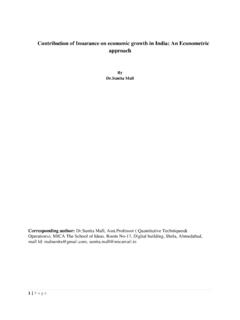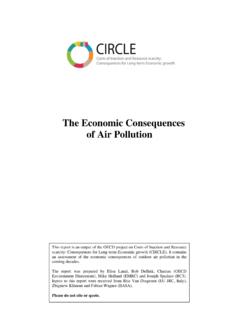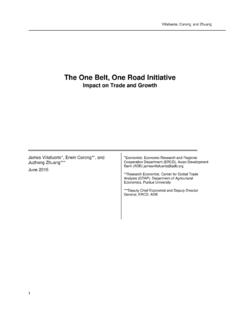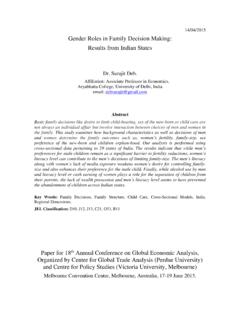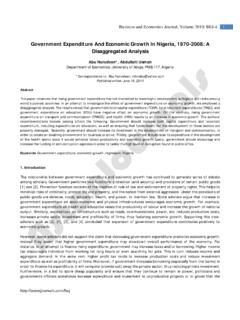Transcription of The Effects of China-US Free Trade Agreement (CHUSFTA)
1 The Effects of China-US free Trade Agreement ( chusfta ). Cai Songfeng, Zhang Yaxiong, Yuan Jianqin (State Information Center). 1. Introduction China and the US are the world's two largest economies, which account for about one third of the value of total world economy. They are not only the world's largest traders but also the destinations for most foreign direct investment. As the world's largest exporter, China has the largest Trade surplus (or merely after Germany) in the globe. The US, as the world's largest importer, has the largest Trade deficit. Sino-US. Trade volume grows rapidly, and the US has become China's largest trading partner and largest investor, while China has grown into the second largest trading partner and the largest source of imports for the US.
2 China-US Trade relation has evolved into the one of the world's fastest growing and the largest bilateral Trade relation. China as the world's largest developing country and the US as a superpower play an extremely important role in building global bilateral and multilateral free Trade zones. Given the positions, the bilateral Trade and economic relations and foreign Trade and economic strategies of the two in the world economy, it will impose a huge economic impact on the two countries and even the world economy if a free Trade Agreement can be reached between the two countries. Therefore, the two countries propose the establishment of chusfta strategic vision at the academic level. In this case, how to promote the construction of the chusfta has become the most important issue.
3 Past experience shows that the negotiation of a free Trade zone is a process of reaching mutual understanding, mutual compromise and benefits sharing. This process requires considerable qualitative judgments on situations and trends, and it also, and more importantly, needs the quantitative analysis of the effectiveness of the policy. The quantitative analysis of gains and losses for both sides supports the progress of FTA. Based on the above logic, this study uses the dynamic GTAP model (GTAP-Dyn) to estimate the potential impact of chusfta on macro economy, sector Trade , output and employment of the US and China, summarizes and analyzes the gains and losses chusfta brings to the two countries, thereby supporting the development of chusfta with quantitative data.
4 2. Research Methods Dynamic GTAP model (GTAP-Dyn) is a dynamic recursive applied general equilibrium model (AGE) of world economy. It extends the standard GTAP model (Hertel, 1997), including cross-country capital flow, capital accumulation and investment adaptability expectations theory. 3. Simulated research scheme Quantification of Sino-US non-tariff barriers Unlike traditional tariffs, non-tariff barriers (NTBs) mainly include price and quantity controls (import quotas, import licenses), technical standards, animal and plant quarantine and import monopoly. There are various types of NTBs and the influence is greater than that of tariff barriers. However, the quantification of NTBs remains a problem.
5 This study uses the findings of the European consulting company Ecorys (2009). From the perspective of tariff equivalents of NTBs, the NTBs between the US. and China are on high levels, as shown in Table 1. In terms of the simple arithmetic average, the tariff equivalent of NTBs on China' imports from the US is 33% on average, while that on the US' imports from China is 14%. As can be seen, the level of NTBs is much higher than the traditional tariff level, and therefore, it can be expected that the cut in NTBs will be the focus of chusfta negotiations. Specifically, the agricultural processing sector which has high levels of tariffs shows an even higher non-tariff rate, and the tariff equivalent of NTBs on agricultural products caused by the differences between Chinese and the US agricultural quality standards is more than 10%.
6 For the food sector which has a traditional low tariff level, the NTBs are also on a high level. For example, the US traditional tariff on food is only around 5%, while the tariff equivalent of NTBs reaches 70%; the US. traditional tariff on car manufacturing is below 1%, while the tariff equivalent of NTBs is over 20%. The service Trade whose traditional tariff is 0 also faces relatively high level of tariff equivalent of NTBs. For example, the tariff equivalent of NTBs on financial services and insurance whose traditional tariff is 0 fluctuates between 30%. and 80%. Table 1 Tariff equivalents of NTBs between the US and China China' imports of US imports of US products (%) Chinese products (%).
7 Rice 11. Wheat 11. Other agricultural products 11. Mining sector Food Textile Clothing and footwear Other manufacturing sectors Chemical products Metal 17. Transport equipment Electrical equipment Machinery equipment Trade , transportation and communication Finance Public service Real estate Average 33 14. Source: GTAP, , Ecorys (2009). * Simulated scenarios It is assumed in this study that the chusfta starts from 2016 to gradually reduce tariffs and non-tariffs between China and the US. As for tariff reductions, the recent free Trade Agreement in Asia has eventually cancelled 90% of MFN tariffs, and the US's recent Agreement has cancelled 96% of such tariffs (Petri, Plummer, & Zhai, 2012), and therefore, this study assumes that chusfta tariff reduction is 93%.
8 (between the two). As for non-tariff reductions, we assume that China and the US. have made substantial progress in terms of reduction of NTBs, 40% of which are cut (mainly by means of reducing import restrictions, unifying standards, cutting technical barriers and quarantine standards, streamlining approval processes and other Trade -facilitating instruments). IV. Simulation results Impact on macro economy Given that China and the US still face high level NTBs, the elimination of these barriers will bring enormous benefits to both countries. As shown in Figure 2, China and the US begin to benefit from it from 2016 (the year when the Agreement is assumed to be implemented). By 2025, China's additional income (GDP) will reach $ billion per year ( of GDP), while the income growth of US will be close to $ billion per year ( of GDP).
9 It is not surprising that China will get more gains, because the existing higher barriers to China mean more potentials for distortion reduction. In addition, both countries will benefit from reducing barriers to the other's products. Finally, the preferential access to the US market will enable China to export more to the US instead of other countries, and meanwhile the US will also export more to China rather than other countries. As shown in Figure 1, the countries not joining CHUSTIA will suffer a loss of $ billion each year. Figure 1 Impact of chusfta on the global economy Source: Simulation results of dynamic GTAP model chusfta enables the sector with comparative advantages to achieve Trade expansion.
10 According to Table 2, chusfta will enable China and the US to increase their global exports by and respectively over the baseline, and their global imports will increase by and respectively over the baseline. Ultimately it reduces China's Trade surplus and the US Trade deficit. Table 5-6 also show that the bilateral Trade will undergo a rapid growth: China's exports to the US will increase by over the baseline, while the US exports to China will increase by over the. Table 2 Impacts of main macroeconomic variables in 2025 relative to the baseline scenario China US. Welfare ($ 100 million) Real GDP (%) Investment (%) Private consumption (%) Government consumption (%) Total exports (%) Total imports (%) Changes in net exports ($ 100 million) Bilateral exports (%) Factor prices (%).



